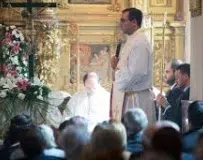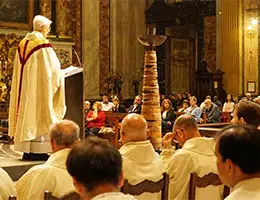 The term homily comes from the late Latin homilĭa , in turn derived from a Greek word. The first meaning mentioned in the dictionary of the Royal Spanish Academy ( RAE ) refers to the discourse or reasoning that is developed to expose or transmit religious issues .
The term homily comes from the late Latin homilĭa , in turn derived from a Greek word. The first meaning mentioned in the dictionary of the Royal Spanish Academy ( RAE ) refers to the discourse or reasoning that is developed to expose or transmit religious issues .
The homily, therefore, is the explanation or reflection that the priest makes after proclaiming the word of God . In it he guides the faithful on the application of divine commands in daily life .
The rituals and prayers of the liturgy can also be explained within the framework of the homily. The intention is that the believer knows the celebration in depth and can participate fully.
The preacher should not include his opinions in the homily: his function is to serve God , transmitting the faith of the Church . It is not an instrument for the religious to make known his opinion or his subjective vision of some event, but rather it is a mechanism to optimize the arrival of religious content to the faithful.
It should be noted that the priest cannot improvise the homily. On the contrary, you have to prepare it thoroughly. The application of the precepts of rhetoric in preaching is called homiletics .
Precisely at this point the debate begins about the best way to prepare a homily. On the one hand, the priest must follow a series of unbreakable rules, so that his sermon is worthy of being presented in the house of God. But it is also true that homiletics proposes the search for unexplored paths to renew the experience in each encounter with the faithful.
Finding a topic is not easy, and this weighs particularly heavily on younger priests. Anyone who has ever attended a Christian mass should know that there is usually a common thread running through the entire ceremony , and that this is not always religious in nature - so to speak - but can be a social problem, a piece of news that has impacted people in the media or simply a useful lesson to become better people.
 For the message to reach the people with the desired impact, the priest must make use of various resources, both material and symbolic. Voice placement is one of the fundamental aspects, since it influences your vocal health as much as the clarity of your words . To successfully achieve this goal you can take theater or singing classes, or follow the advice of your elders.
For the message to reach the people with the desired impact, the priest must make use of various resources, both material and symbolic. Voice placement is one of the fundamental aspects, since it influences your vocal health as much as the clarity of your words . To successfully achieve this goal you can take theater or singing classes, or follow the advice of your elders.
On the other hand, the use of biblical texts to complement the message is a highly recommended resource. It is a very ancient practice that is still effective today, since it gives more weight to the priest's words, supporting them with the word of God itself.
The gestures, the participation of the public, the songs chosen to intersperse the sermons with music and the movement of the priest through the church are other important aspects to enhance communication. The homily that has the most impact is the one with which people can identify, one that they live intensely from the beginning to the end and not a speech that they must listen to passively.
It can be said that homiletics is the art of preparing the homily so that the transmission of religious discourse is effective. Summarizing everything said so far, the cleric must analyze the style, composition and elaboration of the sermon and learn to use his voice , his body and his gestures so that communication with those who listen to the homily is successful.
